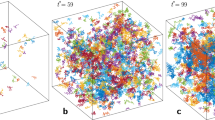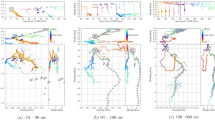Abstract
A RECENT series of experiments1 has demonstrated that the adhesion of ice crystals on collision is a sensitive function of temperature, humidity and crystal-type. However, the effect of electric fields on the adhesion was not examined. Electric fields may have an important effect on the aggregation of ice crystals to form snow-flakes inside thunder-clouds where the crystal concentrations are high and fields of several thousand V/cm have been measured. It appeared possible that the attractive forces between the crystals, produced by polarization charging within the field and accentuated because of the small radius of curvature of the crystal edges, may produce increased aggregation which would be especially important under conditions close to the threshold, in the absence of a field, between adhesion and separation. The experiments described here were performed in order to test this hypothesis.
This is a preview of subscription content, access via your institution
Access options
Subscribe to this journal
Receive 51 print issues and online access
$199.00 per year
only $3.90 per issue
Buy this article
- Purchase on Springer Link
- Instant access to full article PDF
Prices may be subject to local taxes which are calculated during checkout
Similar content being viewed by others
References
Hosler, C. L., and Hallgren, R. E., Min. Ind. Expt. Stn. Penn. State Univ. (Rep. NSF–3477) (1960).
Latham, J., and Stow, C. D., Nature, 202, 894 (1964).
Author information
Authors and Affiliations
Rights and permissions
About this article
Cite this article
LATHAM, J., SAUNDERS, C. Aggregation of Ice Crystals in Strong Electric Fields. Nature 204, 1293–1294 (1964). https://doi.org/10.1038/2041293a0
Issue Date:
DOI: https://doi.org/10.1038/2041293a0
Comments
By submitting a comment you agree to abide by our Terms and Community Guidelines. If you find something abusive or that does not comply with our terms or guidelines please flag it as inappropriate.



